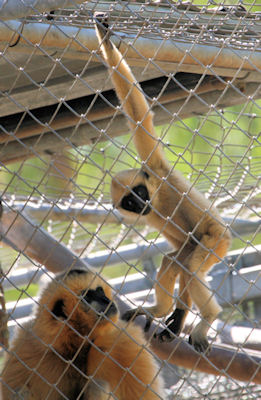Last month, the International Primatological Society reported that nearly 50% of the world’s 634 primate species and subspecies are in danger of going extinct, with more than 70% of species in Asia coming under near term threat. Reading this on the way out to the USA earlier this month set a grim backdrop to an encounter I had very much been looking forward to.
Gibbons are found in three places: the jungles of Asia, the zoo, and, the subject of this post – a gibbon conservation center.

It was with bleary eyes that Erin and I arrived at the Gibbon Conservation Center in Santa Clarita, California, at the virtuous hour of 7.15 a.m. Erin had arranged the visit with Director and founder Alan Mootnick, as an anniversary present (I am a lifelong fan of these hairy cousins). Not an all-comers zoo, the Gibbon Center welcomes groups and serious researchers by appointment, so the personal tour was a bonus; a little politeness and a sensible donation helps.
The declared mission of the Center, established in 1977, is to help ensure the survival, preservation, and propagation of all gibbon species in the wild and captivity, to provide a captive haven for gibbons as a complement to protecting them in the wild, to educate the public and to further our knowledge of gibbon care, and to support ongoing field projects.
Alan warmly welcomed us at the gate and introduced our feet to a tray of disinfectant. Gibbons are highly susceptible to human disease and, with forty in residence, precautions are essential. It is unsettling to learn that more than 75% of Americans have oral herpes but downright scary that the gibbons who contract it will be dead within four days. Volunteers are the lifeblood of this Center, but medical tests are a pre-qualification.
The wire fenced compound houses several individual cages of gibbon family units – typically a male, a female, and one or two offspring. The family theme is very strong and not artificial – this is how gibbons live. One group we became absorbed with comprised a darker haired, white-bewhiskered male, a golden female partner nursing a gangly infant of 1yr, a hyperactive younger son, and an older sister – visible to, but separated from, the group; the consequence of uncontrollable spats at meal times. Anthropomorphising animal behaviour may not be in vogue or politically correct with some, but after three hours close to these families the parallels in behaviour to our own are obvious – whether we like it or not.
A successful breeding programme is essential to meet the Center’s conservation goals, and there was evidence aplenty of this during our visit. Between the five families on which we focused, we saw three recent offspring (including the acrobatic ‘Canter’ in the photo above) and two evident pregnancies. Such prolific reproduction is one indicator that the animals are relatively happy in their captivity. Also, while the chainlink fencing looks intimidating to us, its regular geometry and strength makes it popular with the gibbons, who strangely have spurned more sophisticated apparatus provided for their brachiating delight (that is their characteristic swinging from arm to arm). We certainly saw no evidence of the repetitive and obsessive rocking behaviours characteristic of bored, disturbed or mistreated animals. With no less than nine separate feedings a day, there is little chance of gibbon ennuie setting in within this community.
While Mootnick clearly cares deeply about his charges, he is not overly sanctimonious in pursuing his task. He delights in the gibbon’s hesitant yet rapid two legged walk, likening it to a man walking on hot coals. Indeed, the gibbons’ entertainment value may be their salvation; during the tour a call came in from a major TV company keen to film at the Center, and its not the first time, as this sequence for the L.A. Times and this half-hour interview with Alan Mootnick shows.
Inevitably, the conservation business has its own politics. The main players are zoos providing a more corporate approach; then the ‘activists’ – who seem driven mostly by the principle of keeping gibbons in their countries of origin; then groups like Alan’s (his model is not unique) – which, while a team effort, is also personally inspired with a flexibility that I sensed is not always endearing to more regimented interests. But from the recent visits and best practice exchanges that Alan described – not to mention gibbon exchanges – the Center is an important part of an informal network that essentially pulls together. 2% of donations to the Center go to support projects devoted to conservation of wild gibbons.
Despite the Center’s success, encroaching humanity from an enlarging Santa Clarita is threatening the gibbons and driving the current imperative and funding appeal to relocate and expand operations. Details are on the Centre’s website.
I will be following the fortunes of these California residents with interest, and plan to call in at the Center again over the new year. In the meantime, I would encourage anyone to learn more about the plight of primates, and especially gibbons, and consider supporting the Gibbon Center if you are able.
Other Links
BBC online article by Russell Mittermeier of the International Union for Conservation of Nature
Feature on the center in LA Weekly
http://www.laweekly.com/2008-10-02/la-vida/best-ape-hoots-and-howls/